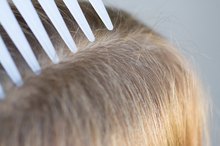The human body can be a host to parasites, both internal and external. Some human parasites live in hair, while some simply find hair to be a convenient hiding spot. Understanding the symptoms of some of these common parasites can help you and your physician to properly diagnose and treat infestations. While some parasites primarily make you uncomfortable by causing severe itching, other parasites, such as ticks, can put you at risk for contracting several serious diseases.
Scabies
Scabies can infest any part of your skin. However, children are more likely than adults to have a scabies infestation in the scalp area, says the Mayo Clinic 12. Scabies is a skin condition caused by a microscopic, burrowing mite. Scabies is highly contagious, and causes severe itching in the affected location. Symptoms include small, irregular blisters along the burrows. The Mayo Clinic suggests that medication called Lindane, available in shampoo form, may be prescribed if you have scabies in the scalp area, although Lindane is not safe for pregnant women or children under two years of age 12.
Lice
The Effects of Dandruff Shampoo on Lice
Learn More
Head lice are tiny parasitic insects that live in your hair and feed on blood from your scalp, says the Mayo Clinic.Symptoms of a lice infestation can include severe itching and the presence of nits, or lice eggs, visible when closely examining hair next to the scalp 12. Lice can usually be killed with over-the-counter shampoos, notes the Mayo Clinic, but prescription shampoos are available if over-the-counter medications fail to kill the lice 12. Pubic lice, also called crabs, are highly contagious and can live around other types of body hair as well.
Ticks
Ticks are sometimes confused with insects, but they are actually arthropods, as are spiders. Ticks cling to weeds and shrubs to be picked up when people brush against them. Ticks like to find hiding spots, such as hair or folds in the skin, to feed on blood. Hard ticks, the most common type found on humans, burrow into the skin, so it is important to remove them carefully to prevent infection or the spread of disease. The Illinois Department of Public Health suggests using tweezers close to the skin to pull out a tick, and then carefully cleaning the bite with antiseptic 3.
- Ticks are sometimes confused with insects, but they are actually arthropods, as are spiders.
- Hard ticks, the most common type found on humans, burrow into the skin, so it is important to remove them carefully to prevent infection or the spread of disease.
Mites
How to Get Rid of Scabies in the Hair
Learn More
There are countless species of mites, many of which live harmlessly on humans. For example, Demodex mites live around human hair follicles and feed on cells. While there are many claims that Demodex mites are responsible for numerous skin problems, from acne to rosacea, results of studies have been inconclusive, notes the California Department of Public Health 3. However, a severe infestation of follicle mites can cause dermatitis, which can be treated with topical ointments, says the California Department of Public Health 3.
- There are countless species of mites, many of which live harmlessly on humans.
- While there are many claims that Demodex mites are responsible for numerous skin problems, from acne to rosacea, results of studies have been inconclusive, notes the California Department of Public Health 3.
Related Articles
References
- Mayo Clinic: Scabies
- Mayo Clinic: Head Lice
- Illinois Department of Public Health: Common Ticks
- Meister L, Ochsendorf F. Head Lice: Epidemiology, Biology, Diagnosis, and Treatment. Deutsches Ärzteblatt International. 2016;113(45):763-772. doi:10.3238/arztebl.2016.0763
- Centers for Disease Control and Prevention. Head Lice: Frequently Asked Questions (FAQs). Updated July 17, 2019.
- Devore CD, Schutze GE. Head Lice. Pediatrics. 2015;135(5). doi:10.1542/peds.2015-0746
- Barker SC, Altman PM. A Randomised, Assessor Blind, Parallel Group Comparative Efficacy Trial of Three Products for the Treatment of Head Lice in Children--Melaleuca Oil and Lavender Oil, Pyrethrins and Piperonyl Butoxide, and a "Suffocation" Product. BMC Dermatol. 2010 Aug 20;10:6. doi:10.1186/1471-5945-10-6
- Abdel-Ghaffar F, Al-Quraishy S, Al-Rasheid KA, Mehlhorn H. Efficacy of a Single Treatment of Head Lice With a Neem Seed Extract: An in Vivo and in Vitro Study on Nits and Motile Stages. Parasitol Res. Published June 11, 2011. doi:10.1007/s00436-011-2484-3
Writer Bio
Melissa Hopkins began writing for the Southern Illinois University newspaper in 2000, where she won several awards. After completing her Bachelor of Arts in English from Southern Illinois University in Edwardsville, Hopkins moved to San Diego, where she worked as a stringer for various publications with the Pomerado Newspaper Group.









